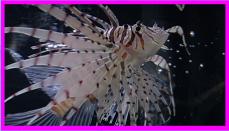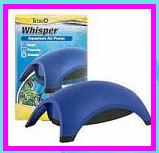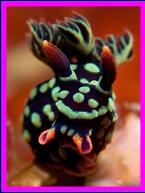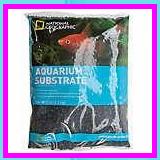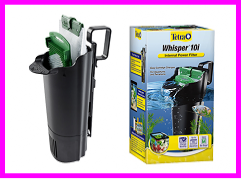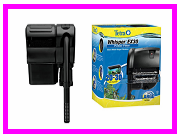Air Pumps
An air pump simply bubbles air through your tank. Air pumps serve two purposes. First, they insure that your tank maintains an adequate concentration of oxygen. An air pump is NOT required for this purpose, as long as your tank maintains adequate water movement together with surface agitation. This is generally the case if external (e.g., box or cannister) filters are used. Second, air pumps can be used to force water through a filter (e.g., sponge or corner filter). If using a UGF, for example, an air pump produces bubbles that force water up the uplift tubes, pulling water through the filter. In larger tanks, powerheads perform the same function. Thus, an air pump is not required, provided your tank has good water circulation.
Thermometers
You will need a thermometer to verify that your tank stays at its proper temperature. Two types are commonly available. The traditional bulb thermometer works the same way as the ones you can buy for your house. They either hang from the top edge of your tank, or float along the surface. The second common design is a flat model that sticks to the outside of the glass. Temperature-sensitive chemicals activate at a specific temperature, either highlighting the numerical temperature or a bar that slides along a scale.
Aquarium thermometers can be rather unreliable (check out the ones on display at a fish store --- they should all register the same temperature, but frequently don't). Thus, thermometers are good for verifying that your temperature is not too far off, but may be off by several degrees in some cases. When buying a thermometer, look at all the thermometers and pick one that has an "average" temperature, rather than one of the extremes.
Gravel
Gravel serves three main purposes. First, it serves as decoration, making your tank look nicer. Second, if using an UGF, gravel is mandatory as it is the filter media (the surface area on which bacteria attach). Third, in plant tanks, it serves as a "substrate" (e.g. dirt) for plant roots. Ultimately, the choice of color, size, etc. is up to you. However, be aware that dark gravel better highlights a fish's colors. Fish adjust their colors to match that of the surroundings, and light gravel tends to wash out a fish's true colors.
Most of the gravel sold in aquariums is plastic coated. For obvious reasons, you should not boil it. Sand can also be used. Be aware that not all gravel is inert. For example, coral, sea shells, dolomite and limestone will leach carbonates into the tank raising its pH buffering capacity. When keeping African cichlids, this is usually desirable. But in most other cases, you will not want your gravel affecting the water chemistry. As a quick test, drip an acid (e.g., vinegar) onto the gravel in question. If it foams or bubbles, the gravel is going to leach carbonates into the water. To be absolutely sure, fill a bucket of gravel with water and measure the pH over a period of a week. If the pH remains stable, it should be safe to use in your tank.
When used for the first time, gravel should be washed thoroughly. Simply rinse clean water through it until the water comes out clear (tap water is fine). For example, put the gravel in a bucket of water, fill it with water, and churn the gravel up. Drain the water and repeat the procedure until the water remains clear. Before using gravel of unknown origin (e.g., not purchased at a fish store), you may (as a precaution) want to boil it for 15 minutes to kill unwanted bacteria.
Filters
One of the most important parts of fishkeeping is also one of the easiest. Just like an air filter cleans the air we breathe, an aquarium filter cleans the water your fish breathe. It also helps keep your aquarium looking pristine. The best aquarium filters process three types of waste:
--Solid waste is any type of dirt, particle, or debris floating in the water like fish waste and uneaten fish food. This type of waste is removed through mechanical filtration.
--Dissolved waste is organic compounds, such as decaying tissue in tap water, and can cause odor and discoloration of the water. This type of waste is removed through chemical filtration.
--Biological waste includes all unwanted contaminants, like ammonia and nitrate, which have to be biologically processed rather than filtered. This type of waste is removed through biological filtration.
Power filters typically use disposable cartridges and hang on the back edge of your aquarium.
Internal filters are primarily made for smaller aquariums (under 20 gallons) and are placed inside the aquarium to provide water movement.
Canister filters provide excellent filtration for larger aquariums or aquariums with a lot of fish. They are usually placed in a cabinet or stand beneath the aquarium.
Filter maintenance
First, always make sure there is water in the pump chamber. If you don't, the filter will pull in air instead.
Keep an eye on how much water is in your aquarium-most filters need the water level to be about one inch from the lip of the filter.
Make sure your bubble walls and/or air stones are not directly under the intake tube. If bubbles go up the main tube, it will cause a rattling sound and may stop your filter from working.
Always use gravel in your aquarium instead of sand. Sand can cause problems with the impeller, because it gets between the magnetic impeller assembly and the energizer, preventing it from turning. If you do have sand, a good option is to purchase a mesh net from your local pet store, or even use a piece of panty hose, and place it on the strainer. Your filter will pull out the waste, but it won't pull up the sand.






